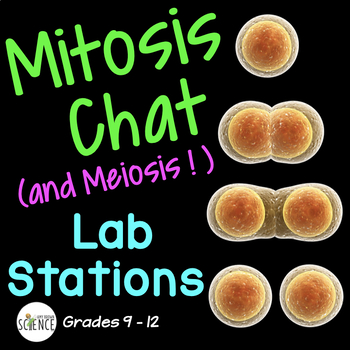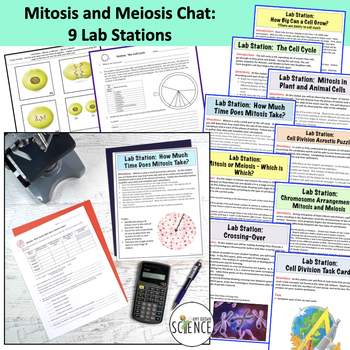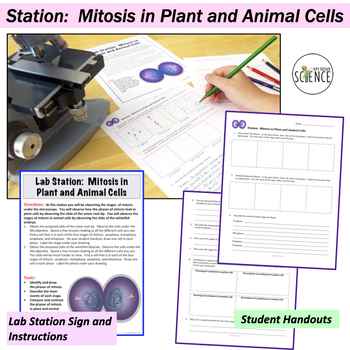Mitosis and Meiosis Chat Cell Division Lab Stations
- Zip
What educators are saying
Description
These 9 Mitosis and Meiosis Chat lab stations will ensure that your students have mastered the concepts of cell division. Students will explore the limits to cell size, learn to recognize the stages of mitosis and meiosis, determine the result of each type of cell division, and think about why mitosis and meiosis occur in different cells. Students will compare mitosis in plant and animal cells and use a simple calculation to determine how much time a cell spends in each stage. Students will explore the cell cycle, and crossing over. Students will work together to solve a problem, complete a task, and /or carry out a small experiment at each of the 9 stations. I use the word “chat” to emphasize to my students that they are to work together and have a productive discussion at each lab station in order to maximize their understanding and mastery of the concepts being covered.
What is included in this product?
- 9 Lab Station Activities
- 15 Pages of Student Worksheets
- 9 Mitosis Chat Lab Station Instruction Cards
- 4 Pages of Task Cards
- 5-Page Teacher Guide
- 13-Page Teacher Answer Key
Do just a few lab stations or do them all! All materials are completely editable.
+++++++++++++++++++++++++++++++++++++++++++++++++++
Love my chat activities? Check these out:
- Biology Chat
- Chemistry Chat
- Physics Chat
- Lab Safety Chat
- Technology Chat
- Science Skills Chat
- Microscope Chat
- Cell Chat
- Ecology Chat 1: Introduction to Ecology
- Ecology Chat 2: Population Ecology
- Plant Kingdom Chat Lab Station Activity
+++++++++++++++++++++++++++++++++++++++++++++++++++
What are the benefits of this activity?
- Group work is an important part of what we do in a science class, and it is a skill that will be needed throughout life. Lab station activities teach students how to work together to achieve a goal.
- Lab Stations break down the information into smaller and more manageable units. This prevents students from becoming overwhelmed when faced with massive amounts of information.
- The lab stations will ensure that students have mastered the concepts of cell growth and division.
What will the students be doing?
There are 9 lab stations. Students will rotate through the stations, completing the tasks at each station. Each station will highlight a cell division-related task to be completed by the group as well as a worksheet of analysis questions.
Need to save paper? No problem! Place one copy of the student worksheet at each lab station and have students complete the work on their own notebook paper.
Concepts covered at each lab station:
- Station 1: How Big Can a Cell Grow?
- Station 2: The Cell Cycle
- Station 3: Mitosis in Plant and Animal Cells
- Station 4: How Much Time Does Mitosis Take?
- Station 5: Mitosis and Meiosis Acrostic Puzzle
- Station 6: Mitosis or Meiosis? Which is Which?
- Station 7: Arrangement of Chromosomes in Mitosis and Meiosis
- Station 8: Crossing Over
- Station 9: Cell Division Task Cards
Please Note:
If your students do not have previous knowledge about mitosis and meiosis or the vocabulary used in a cell division unit, prior instruction will be needed before attempting these lab stations. These lab stations are not intended to be a “first day of instruction” lesson. These lab stations are designed for review, reinforcement, and to build upon the foundation of knowledge that your students already have. This resource does not include teaching materials such as textbook readings, informational text readings, or a teaching PowerPoint.
Click this link to view my Cell Division (Mitosis and Meiosis) Teaching PowerPoint and Notes Set.
Materials and Supplies Needed:
- Three round balloons
- String
- Meter stick
- Calculator
- Colored pencils
- Microscopes
- Prepared slides of onion root tip mitosis
- Prepared slides of whitefish blastula mitosis
The 5-page teacher guide includes:
- Purpose of the activity.
- Description of what students will be doing.
- How to carry out your role as facilitator.
- Materials List
- Safety Precautions
- Complete instructions for how to set up each lab station.
- Tips and suggestions for successful completion of the activity.
This resource also includes a very detailed 13-Page Teacher Answer Key
Related products include:
Mitosis and Meiosis: A Complete Unit Plan Bundle
Mitosis Meiosis Cell Division Task Cards
Biology Buzz Words: Cell Division
Mitosis and Meiosis Google Sheets Hidden Picture Reveal Activity- 3 Game Set
Cell Division (Mitosis and Meiosis) Acrostic Puzzle
Mitosis and Meiosis Cell Division Powerpoint with Notes
Mitosis, Meiosis, Cell Division - Set of 3 Homework Assignments
Crossword Puzzle on Mitosis and Meiosis
Mitosis and Cell Division Powerpoint Jeopardy Review Game
Mitosis and Meiosis Cell Division Unit Test
Mitosis and Meiosis Simulation Lab with Pop Beads
Cell Structure and Physiology Interactive Notebook Pages, Warm Ups, or Bell Ringers
For updates about sales and new products, please follow my store:





